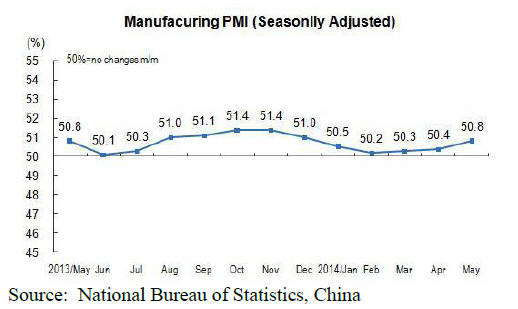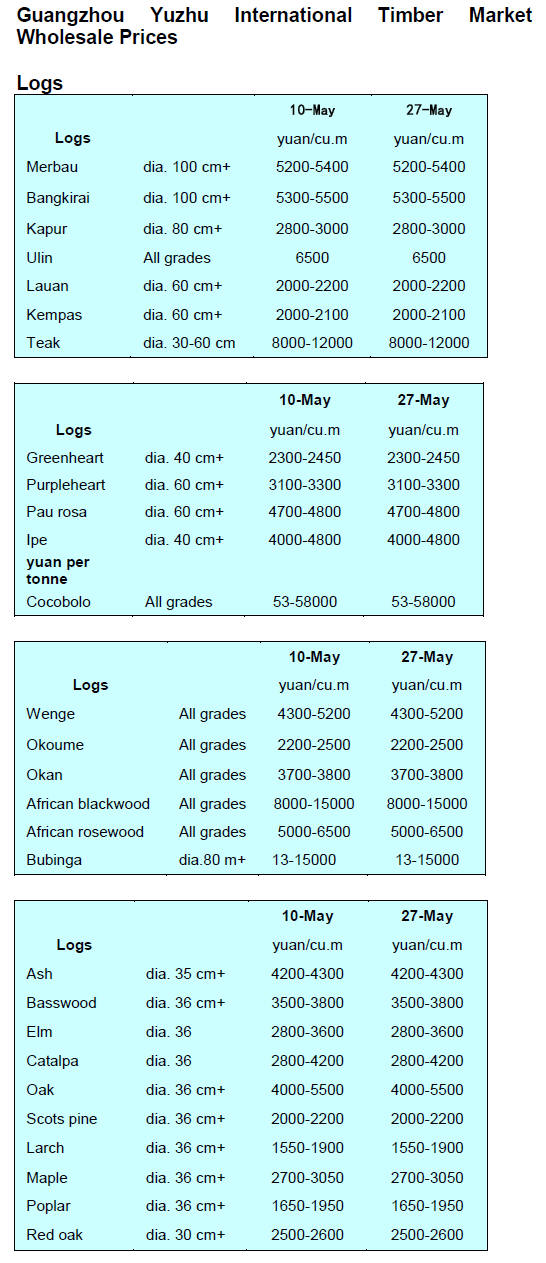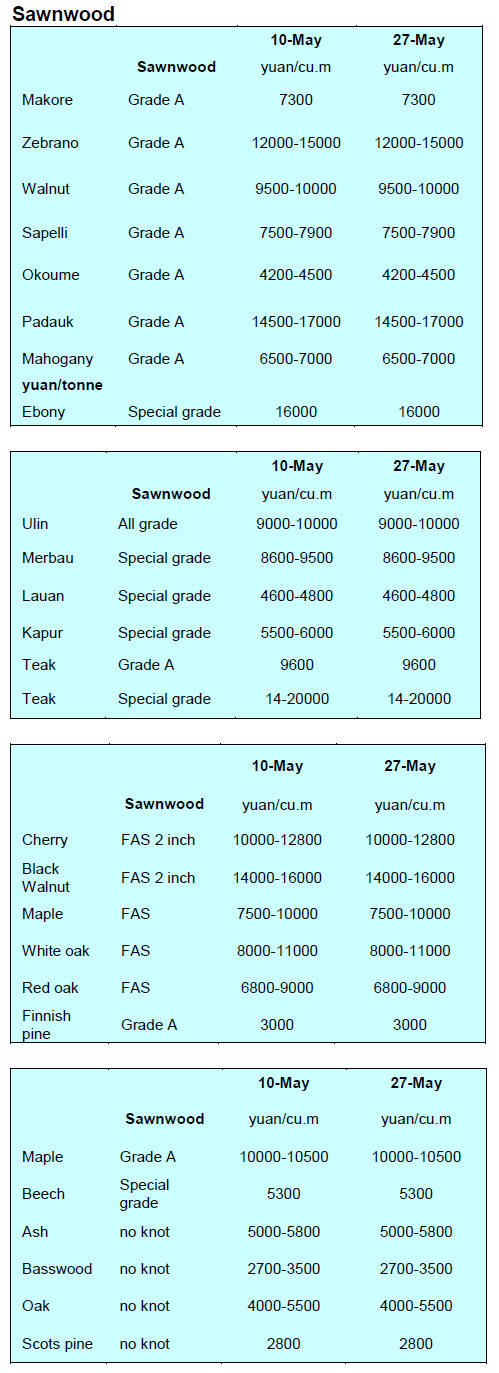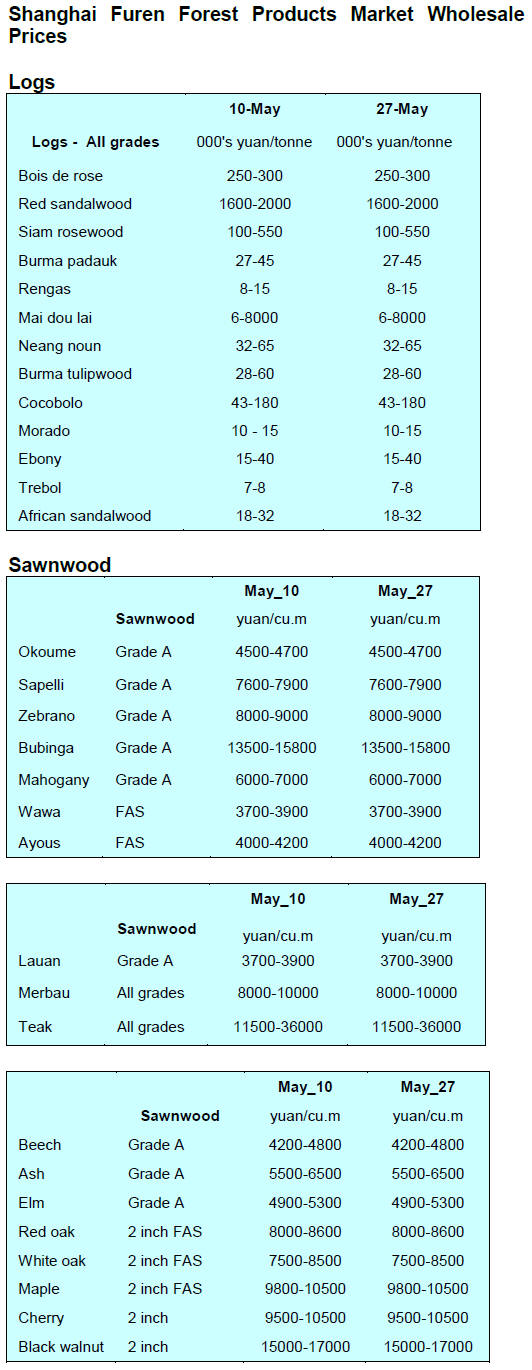US Dollar Exchange Rates of
11th June 2014
China Yuan 6.2283
Report from China
PMI up for 3 consecutive months
In May 2014, China's purchasing managers index (PMI)
for the manufacturing was released by the National Bureau
of Statistics. The May PMI for the sector stood at 50.8, 0.4
points higher than in April. The May figure consolidated
the growth trend for three consecutive months.
For more see:
http://www.stats.gov.cn/english/PressRelease/201406/t201
40604_563603.html

In terms of size of enterprises, the PMI for large-sized
enterprises was 50.9 percent, slightly up month-on-month
and in positive territory. The PMI for medium-sized
enterprises was 51.4, again up on the previous month
while the index for small-sized enterprises was still in
negative territory at 48.8.
In summary, of the five sub-indices comprising the PMI,
three improved and two weakened.
Production index: 52.8 up month-on-month.
New orders index: 52.3up month-on-month.
Raw materials inventory index: 48.0 down on
April.
Employed person index: 48.2 down month-onmonth.
Supplier delivery time index: 50.3 up month on
month.
The new export and import indices reflecting
foreign trade in manufactured goods were 49.3
and 49.0 respectively both in negative territory.
Stimulus measures boost May retail sales
May 2014 retail sales growth beat analyst‟s expectations
by growing by 12.5 percent year-on-year. The government
had recently eased monetary conditions and introduced
other measures aimed at giving the economy a boost. The
„mini‟ stimulus appears to be working given the
improvement in retail sales.
From January to May total retail sales of consumer goods
was yuan 10,303.2 billion, up by 12.1 percent year-onyear.
Online retail sales increased 53.2 percent.

US$ 90 billion outward investment in 2013
Early this year Forest Trends published a report ¡°Chinese
Overseas Investment in Forestry and Industries with High
Impact on Forests: Official Guidelines and Credit Policies
for Chinese Enterprises Operating and Investing Abroad¡±.
The following excerpts draw on this report.
For the full report see http://www.foresttrends.
org/documents/files/doc_4203.pdf
In 2013 Chinese enterprises invested US$90 billion in
5,090 foreign companies in 156 countries, a year on year
increase of 17%.
Of the total, investments in Hong kong, ASEAN, EU,
Australia, USA, Russia and Japan totalled USD65.5
billion around 73% all overseas investments. But
investment flows to Hongkong, the EU and Japan fell in
2013 compared to a year earlier.
The value of China‟s investments grew in Russia (US$4.1
bil.), the US (US$4.2 bil.), Australia (US$3.9 bil.) and
ASEAN (US$5.7 bil.). The greatest increase was seen in
investments in Russian companies.
In terms of investment categories, 90% of China‟s outward
FDI in 2013 was to service industries (33%) followed by
mining (22%), wholesale and retail (15%), manufacturing
(10%), construction (7%) and transportation (3%). The
pace of growth in investment in the construction sector
was particularly high in 2013.
The data from the Ministry of Finance indicates that some
527,000 Chinese workers were sent to foreign companies
in 2013, a year on year increase of 15,000 employees. In
total by the end of 2013, China had around 7 million
people overseas employed in support of its outward
investment.
The majority of China‟s outward FDI originates from
state-owned enterprises (national, provincial, and
municipal) although the government is encouraging
outward FDI by private enterprises.
Geographically, enterprises in the industrial and
commercial centres in the coastal cities and provinces are
responsible for most outward FDI. Provinces where
forestry and wood processing is strong such as Shandong
and Yunnan tend to feature in FDI in the timber sector.
A powerful incentive for outward FDI is provided by the
government in the form of financial backing. Chinese
enterprises on an approved list benefit from the
government‟s financial support in the form of access to
below-market rate loans, direct capital contribution and
subsidies associated with official aid programmes.
The incentives are backed up by various guidelines to
banks and financial institutions to encourage them to
ensure their clients comply with environmental and social
standards, including host-country laws and regulations.
The most recent green credit guidelines (2012) are the
most comprehensive yet, but as with the other f guidelines,
their implementation has so far been patchy. However, the
government has plans to enforce them more strictly. All
guidelines and policies share the basic and fundamental
requirement that host-country laws and regulations must
be followed.
Despite the poor implementation of past guidelines the
most recent environmental protection and green credit
guidelines offer clear opportunities for host-country
governments, NGOs, and campaigners to highlight
occasions where Chinese companies are operating in
breach of their own government‟s regulations and laws.
Direction of outward investments
According to records kept by China‟s Ministry of
Commerce, investments in forestry and other land-use
sectors have been made in the following regions and
countries:
• Africa: Fourteen countries in Africa have received FDI in
agriculture and forestry, in particular Gabon, Zambia,
Equatorial Guinea, Liberia, Republic of Congo and
Cameroon.
• Asia: Outward FDI in logging and processing has been
mainly directed to Laos, Myanmar, Thailand, and Korea.
Efforts have been made to establish plantations in areas
previously under opium poppy cultivation in Laos,
Thailand, and Myanmar.
• Latin America and Caribbean: While less significant
than Africa or Asia, Chinese investments have been
expanding in Brazil, Argentina, Venezuela, Peru and
Guyana.
• Russia: Chinese investment has focused on logging,
timber processing, pulp and paper and other products and
is concentrated in the border areas in Siberia and the
Russian Far East. Chinese outward FDI has been
encouraged by the Russian and Chinese governments
through supportive programmes that began in 1997.
  
¡¡
|